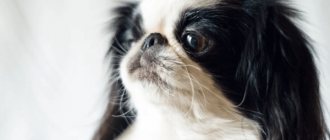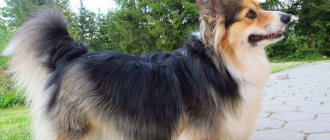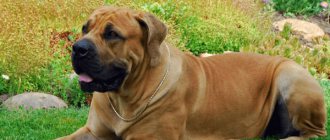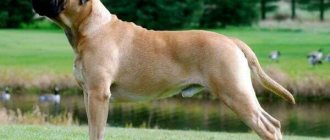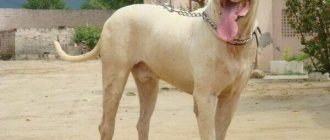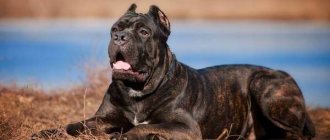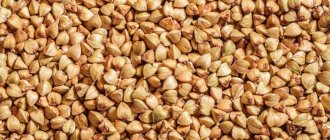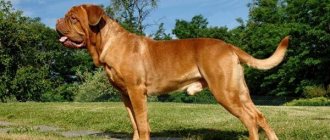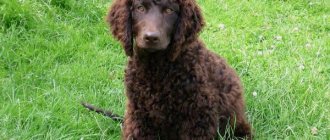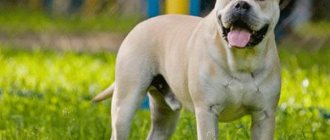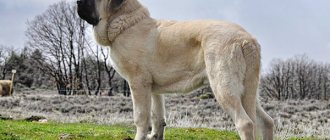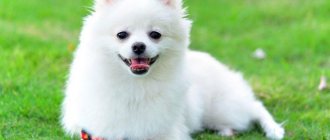The name "mastiffs" refers to a fairly large group of breeds, which includes Tibetan, English, French, Neapolitan, South African, American, Brazilian, Pakistani and other dogs with similar characteristics.
It took more than a hundred years to develop the Japanese Mastiff breed.
The result was a dog with clear fighting skills, capable of both hunting and home guarding.
These dogs, having a strong-willed character, recognize as masters only those who are able to cope with them.
But this does not make them worse, but on the contrary, they prove their superiority over other breeds.
Origin story
A hundred years ago, Japan was in great need of a fighting and hunting dog capable of teamwork . At that time, the Nihon Inu breed existed and was popular in this country.
They were used in hunting, but they did not obey their owner well, which was unacceptable.
At the same time, dog fighting was very popular in Japan . The Nihon Inu were much inferior to their opponents because they were much smaller and weaker. This hurt the honor of the samurai and the Japanese did not like it, because everyone wanted to win.
It was decided to create a breed through selection that would satisfy the needs of everyone. The Nihon Inu has been crossed with various Western breeds. It was a bulldog, bull terrier, mastiff, mastiff, pointer.
The result of such long work was the Tosa Inu breed, or Japanese mastiff . This dog was hardy, large and obedient.
Many years have proven that the Japanese Mastiff is not a family dog at all, but a fighting dog. The breed is still banned in some US states.
Shikoku
An ancient Japanese breed in origin is the closest relative of the Shiba Inu. Adult dogs grow over 50 cm at the withers, with short, dense hair that requires almost no grooming. Shikoku can be kept in an apartment, but then they need to be walked regularly, because by nature they are active and agile hunters.
Photo: funart.pro
Description of the breed
- This is a powerfully built dog with well-developed muscles and high withers;
- Height does not exceed 75 cm, weight – 60-70 kg;
- The stomach is tucked, the back is straight;
- The limbs are strong, with large round pads located on them;
- The neck is large, there is a fold on it;
- The head is wide and rectangular, with a clearly defined transition from the forehead to the muzzle;
- The ears are drooping and cannot be cropped;
- The nose is black, the eyes are dark shades, expressing calm and confidence;
- The mouth is powerful and strong, well developed;
- The tail is wide at the base, narrowing towards the end. Located high.
Hin
The tiny toy breed, weighing about 3 kg, is one of the oldest breeds in Japan. Chins can live in absolutely any room, but are not at all adapted to the street. Such dogs are easy to train, but cannot tolerate boredom, so you will have to try to choose more interesting tasks.
Photo: krasivosti.pro
Did you like the post? Subscribe to our channel in Yandex.Zen, it really helps us in our development!
Character traits
Only a person of strong character, and certainly not a beginner, can properly raise a dog of this breed.
Mastiffs are neither stupid nor uncontrollable . On the contrary, they are distinguished by attentiveness, balance, intelligence and calmness.
But behind this there is also a great inner strength, which only a person equally strong internally can subjugate.
Leadership qualities are important when raising and training a mastiff..
The dog has developed protective potential. She will always stand up for the owner and those people who have earned her respect. He is quite wary of strangers, although without barking or aggression.
The dog senses the mood of people, so it does not tolerate falsehood and pretense . In a relationship with a mastiff, you need to be sincere and open, show your real intentions. This is the only way you can win the dog’s favor.
Hitting a mastiff is a bad decision . He will be angry with you, he will be afraid, and this is not respect. In this case, be prepared for the fact that at the decisive moment the dog will simply turn away from you.
Mastiffs do not like unfamiliar dogs or other pets in general. They will treat them with aggression only if they did not grow up together.
The dog is difficult to train, so it should be trained from an early age.
Expert opinion
Kozhevin Semyon Kirillovich
Expert dog handler.
“This dog is clearly not for the family or for interacting with small children. Mastiffs are proud and calm, but they definitely will not tolerate disrespect, and they perceive children as puppies, that is, they can bite and growl. If you have managed to earn the favor of a mastiff, he will respect and protect you to the death. These are extremely loyal dogs that will fight for their owner to the last.”
Who is the dog suitable for?
Tosa Inu is not a breed for beginners . Suitable for people with a strong character who are not afraid of difficulties.
The Japanese Mastiff at rest creates a deceptive impression. In seconds he turns into a ferocious dog if there is a reason. Therefore, thoughtful training and contact with the owner is necessary. A child or elderly people will not cope with such a task. They become attached to an understanding owner for life.
Breeders say that the Japanese mastiff looks closely at a person for a long time and only after “checking” recognizes the owner.
For decades, Tosa Inu have participated in battles, in which certain qualities have been cultivated: toughness, speed of movement, courage and the ability to make decisions without the owner. However, aggression is considered a defect in the breed. The Tosa Inu has a viciousness that can be controlled. Suitable for protecting an apartment, site or person . They rarely raise their voices and work to capture.
Japanese mastiffs do not pose a threat to families and are careful with children . If they live with other dogs, they can sort things out in fights, building a hierarchy. The main thing should be the person. This is normal, but caution is a good idea. There are no problems with cats or rodents, provided they get used to it or live together since childhood.
Advantages and disadvantages
Advantages:
- Calmness and balance;
- A certain phlegmatic attitude towards others when everything is calm;
- Acute sense of smell and hearing;
- Quick response to what happened;
- Security and protective potential;
- Always comes to the owner's defense;
- Majestic appearance;
- Developed muscles.
Flaws:
- They are difficult to educate and train;
- If these aspects are delayed, the dog will grow up to be aggressive, controlled and antisocial;
- Not suitable for apartment;
- Not suitable for spending time with children;
- He has a strong character and obeys a person with authority, which in itself is not easy.
Japanese Chin
We should start the review with the most charming Japanese dog, which has long taken a place in the hearts of a large number of people. We are talking about the Japanese Chin. This little dog is so cute, active and playful that it simply has no equal among miniature pets. Only the Pekingese could compete with her, but his short legs and heavy landing simply do not allow him to catch up with the perky, self-confident and light little one.
The Japanese Chin is filled with a sense of self-importance and wants to be the center of everyone's attention, so it becomes very upset if its own attention is rejected. For more than 1000 years, chins belonged only to the imperial family, being royal favorites. One of the emperors even ordered them to be worshiped, declaring the dogs sacred. They had their own servants and doctors, and only members of the imperial family could own them. Especially miniature specimens were kept in cages, in a suspended state. A pair of Chins was given to Queen Victoria in 1853, which influenced the further development of the breed.
The Japanese Chin is unusually graceful, with a proud posture and luxurious coat. The coat color can be white with either black spots or red markings. The more distinct and brighter the red color, the better it is considered. The spots on the head and ears should be placed symmetrically relative to each other. Some believe that chins are descendants of a lion and a butterfly: they really look like a lion with their muzzles and are mobile, fluttering like butterflies.
How to properly care
Despite all the difficulties that you may encounter when raising a Mastiff, caring for a Mastiff is not that difficult . His short coat does not get particularly dirty; it is enough to brush it several times a week with a furminator.
If the dog gets very dirty while playing outside, then bathe him using special washing shampoos for dogs. However, this procedure should not be repeated more than once a month.
Mastiffs need to have their nails trimmed as they grow . But this task is not easy, because the Tosa Inu is far from a decorative dog. You need to be accustomed to this procedure from childhood, and if you are not confident in your abilities, then it is better to contact a groomer.
NOTE!
You need to wipe your eyes every morning and clean your ears at the end of each week.
You need to walk your mastiff every day, and these should be unusual walks . This breed requires constant physical activity, as well as constant honing of already acquired skills.
Tosa Inu is not suitable for an apartment . Such a dog should have a lot of space where it can run and frolic. This breed is also prone to colds, so damp rooms and low temperatures are not suitable for it.
Hokkaido
The second name of this breed is Ainu, and in appearance it resembles a Spitz. These are very ancient, rare and valuable dogs, ideally suited for mountainous terrain and difficult living conditions. She was not specially bred, which means that the main features of her appearance and character were formed under the influence of natural selection. Hokkaido are very brave, decisive and have good sense of direction in new terrain or unfamiliar situations.
Photo: funart.pro
The most beautiful dog breeds: names and photos (catalog)
Nutritional Features
An adult dog needs to be fed twice a day . The diet must be nutritious and balanced for the dog to grow muscles. A veterinarian can help you create a menu.
He will describe the diet for the mastiff step by step. Natural nutrition is necessary if you plan to show your dog for fighting.
IMPORTANT!
If you don’t have much time to cook, and the dog performs the duties of a watchman and security guard, then you can feed him commercial food.
The main thing is that they are premium and super premium.
Where to buy Tosa Inu
Before you start looking for a breed, check the laws in your country. In some countries, including Australia, the UK, New Zealand, Norway, Denmark and others, ownership of tosa is either expressly prohibited or legally restricted.
Some states, cities, local governments, landowners and insurance companies also exclude tosa. In Japan, this breed is used for dog fighting, but in other parts of the world it is bred as a show dog and companion. The breed is rare, so finding a breeder can be difficult.
You can start your search for a dog at animal shelters to give a home to a lonely animal, or contact reputable breeders and buy a puppy with a proven health condition. They should not be released into a new home until they are at least eight weeks old and should also be vet checked.
How to choose?
When choosing a mastiff puppy, you should contact a nursery where breeders have already raised this breed.
He needs to be tested, because fighting dogs are no joke:
- The puppy must already be 2 months old;
- It should be of medium size without any developmental defects in the jaw, tail joints, eyes and ears;
- Six should be bright, without bald spots;
- A healthy puppy's belly is soft and free of lumps;
- The baby should not be too thin, but not too fat either;
- The normal temperament for a Japanese Mastiff puppy is curiosity, playfulness, and lack of cowardice and aggression.
Characteristics of the Tosa Inu
| Attachment level | Average |
| Friendliness | Short |
| Child friendly | Average |
| Loyalty to other pets | Short |
| Exercise needs | Average |
| Playfulness | Short |
| Energy level | Average |
| Learning ability | Average |
| Intelligence | Average |
| Tendency to bark | Short |
| Shedding amount | Short |
Sakhalin Husky (Karafuto-ken, Sakhalin Laika, Gilyatskaya Laika)
- The official name is Sakhalin Husky.
- FCI classification - not recognized.
- Origin – Russia.
- Patronage – Japan.
- Dimensions: 56–66 cm.
A large, strong, independent breed bred to transport goods. Considering the age of the breed group, it can be assumed that the Sakhalin Huskies were repurposed from hunting and herding dogs into sled dogs. It is known that at the time of its inception, among local tribes, baiting of bears with dogs served as entertainment. Having gone through a long journey of formation, Karafuto-ken acquired a calm and reasonable disposition, good health, endurance and incorruptible devotion to the owner.
This is interesting! During the war years, the Sakhalin Laika was considered one of the best front-line breeds in the USSR.
In 1958, 15 Sakhalin Huskies were forced to live in the Antarctic desert. The expedition members could not return for the animals because the weather conditions threatened people's lives. They returned for the dogs a year later. Two miraculously surviving Huskies were discovered near the abandoned camp. Based on these events, the films “Antarctica” and “White Captivity” were made. In the film “White Captivity”, the role of Sakhalin Huskies was played by Malamutes and Siberian Huskies.
Note! The Sakhalin Laika is considered an endangered breed. Breeding continues only in Japan, but in a very modest format.
Japanese Terrier
This breed is the only one of the terrier group bred in Japan. Their breeding began at the beginning of the 20th century. The goal was to get a decorative dog that would easily adapt to life in densely populated cities.
During breeding, Italian Greyhounds, Smooth Fox Terriers, Manchester Terriers and small aboriginal dogs were crossed. The result was a miniature dog (30–33 cm and 2–4 kg), with a compact body, long legs and very short hair (up to 2 mm).
The Japanese Terrier is easily distinguished by its unique tricolor coat. The head is decorated with a black mask with red and white spots, and on the light body there are dark or reddish-brown markings.
The Japanese Terrier is an excellent dog for an apartment and a family. He is friendly, playful, and gets along with children. However, it can chase cats and rodents, and is wary and somewhat cowardly with strangers. The dog is also easy to care for: weekly brushing with a soft brush and occasional washing are enough. The only thing is that the pet cannot stand the cold, so from autumn to spring you will need clothes.
On topic: Varieties of terriers
Kishu
Kishu is another ancient breed from the Land of the Rising Sun, recognized as a national treasure. It has the typical external features of Japanese breeds: a triangular head, pointed erect ears, a curved tail and double coat. The color is most often white, but there are also representatives with a red or zone color.
Kishu is a rare breed. There are not many dogs even in Japan: about 11–13 thousand. And outside the country they are generally difficult to meet.
Despite their average size (49–52 cm), kishu are fearless hunters of large animals. They bravely drive bears and wild boars, hold them until the hunter arrives, jumping onto the back of the prey and clinging to it with their teeth. Pets can also guard the territory or herd livestock.
Kishu are unpretentious and can live in the harshest conditions. They don't care about heat or cold. But minimal care is needed: washing once every couple of months, weekly brushing, brushing teeth and ears, and trimming nails as they grow.
Breeds of white dogs with names and photos.
Ryukyu
Ryukyu is a medium-sized dog: weight varies from 15 to 20 kg, weight - from 46 to 55 cm. The breed looks intimidating and resembles a wild dog. In fact, they are loyal, affectionate and obedient companions. Although, like all “Japanese”, they are freedom-loving and willful.
Ryukyu love their owner and family very much. But they are wary of strangers, sometimes aggressive. And their hunting instincts do not allow them to get along with other animals.
The breed originated on the Ryukyu island archipelago. It almost disappeared during World War II. Restoration began in the 1980s. But even today representatives are rare: there are only about 1,000 dogs.
The color of the Ryukyu is usually brown, less often brindle with a predominance of red, black or white.
It is better to keep Ryukyu in a country house with a large fenced area. If you keep them in an apartment, you will need daily walks lasting at least 2-3 hours. The rest of the care is simple: weekly brushing, as well as cleaning the ears and teeth.
